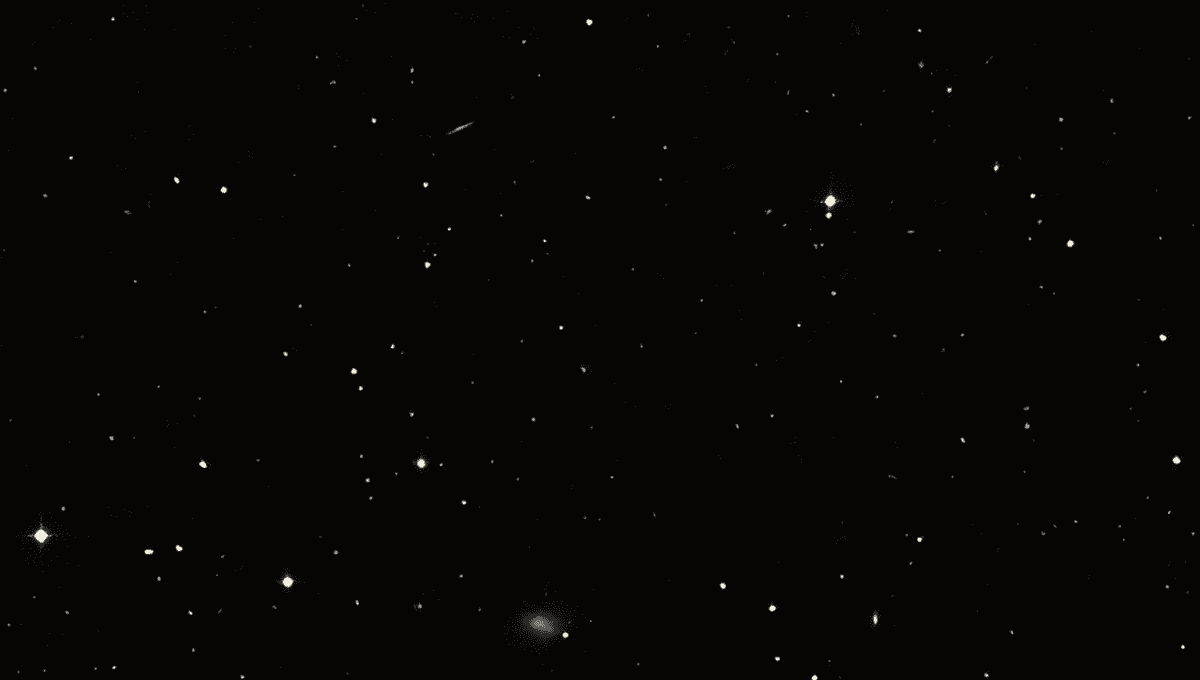
The nearby dwarf galaxy Segue 1 is exceptionally faint for its mass, which has puzzled astronomers almost since its discovery. A new paper proposes this could be because it hosts a ridiculously oversized supermassive black hole, relative to Segue 1’s population of stars. They have calculated that a black hole about 450,000 times the mass of the Sun provides the best fit with observations.
The Milky Way is surrounded by many much smaller satellite galaxies. Although these are nearby, at least by the standards of galaxies, the only two we can see with the naked eye are the Magellanic Clouds. Bright parts of our own galaxy obscure some, but most are just too small and faint.
Segue 1 is unusual amongst this collection. With only 1,000 stars, most very low mass, one could easily question whether it deserves to be called a galaxy at all, even a dwarf one. After all, there are plenty of open clusters within the Milky Way, and globular clusters around it with a great many more stars.
On the other hand, it would need to have something like a million solar masses to avoid flying apart, given the speed and distance of its stars. Since it shows many signs of being exceptionally ancient, this implies a great deal of mass we cannot see – indeed, it has the highest estimated mass relative to the light it emits of any known galaxy.
Since the recognition of Segue 1’s high mass, the assumption has been that it is exceptionally rich in dark matter, although why so much mysterious substance would clump in one place with little ordinary matter has not been known.
However, a group of graduate students taking a class taught by Professor Karl Gebhardt and Dr Richard Anantua of the University of Texas at Austin and San Antonio, respectively, considered an alternative possibility. They looked into how massive a black hole would need to be to stop Segue 1’s stars from leaving.
The students not only concluded that a black hole could do the job, but that, if it were about 450,000 solar masses, it would explain why stars are moving rapidly at the center of Segue 1 but slowly on the outskirts.
Although 450,000 solar masses is puny for the supermassive black holes at the center of large galaxies – the Milky Way’s is about nine times greater – it would be enormous for such a small collection of stars. We don’t know why something so massive would just be floating in space, almost on its own, and 75,000 light-years from us.
“Our work may revolutionize the modeling of dwarf galaxies or star clusters to include supermassive black holes instead of just dark matter halos,” said first author Nathaniel Lujan in a statement.
“We designed this course to foster collaboration between our two universities,” said Gebhardt. “Initially, the project was to model the gravitational dynamics inside Segue 1. That it resulted in a significant discovery is a real testament to the talent of these students and their determined, hard work.”
There is evidence that Segue 1, as one of the closest satellite dwarf galaxies, is being tidally stripped by the much larger gravity of the Milky Way, losing stars and gas from its outer edges. The authors think it may once have been considerably bigger, and that even this enormous black hole couldn’t hold onto most of its original galaxy against the Milky Way’s influence.
Galaxies with large black holes and surprisingly few stars have been spotted in the early universe, billions of light-years away. They’re known as Little Red Dots, and only observed because the black hole at the core is actively feeding, creating a bright accretion disk. The authors raise the possibility that Segue 1 is a Little Red Dot 100,000 times closer, but so faint it was only discovered this century, because the black hole has no accretion disk.
The stars-to-mass ratio is not the only odd thing about Segue 1. A decade ago, it was found to have proportionally less metal (elements heavier than helium) than any other galaxy known at the time. This has been taken as a sign that it stopped evolving nearly 13 billion years ago, and is frozen in the state of a galaxy from the extremely early universe.
However, Segue 1 has company when it comes to being a relic. Other dwarf galaxies that orbit the Milky Way that show the same lack of metals include Bootes I, Tucana II, and Ursa Major I. Although these are similarly faint, they are much less massive than Segue 1, and are therefore easier to explain.
The study is published in Astrophysical Journal Letters.
Source Link: A Nearby Galaxy Has A Dark Secret, But Is It An Oversized Black Hole Or Excess Dark Matter?